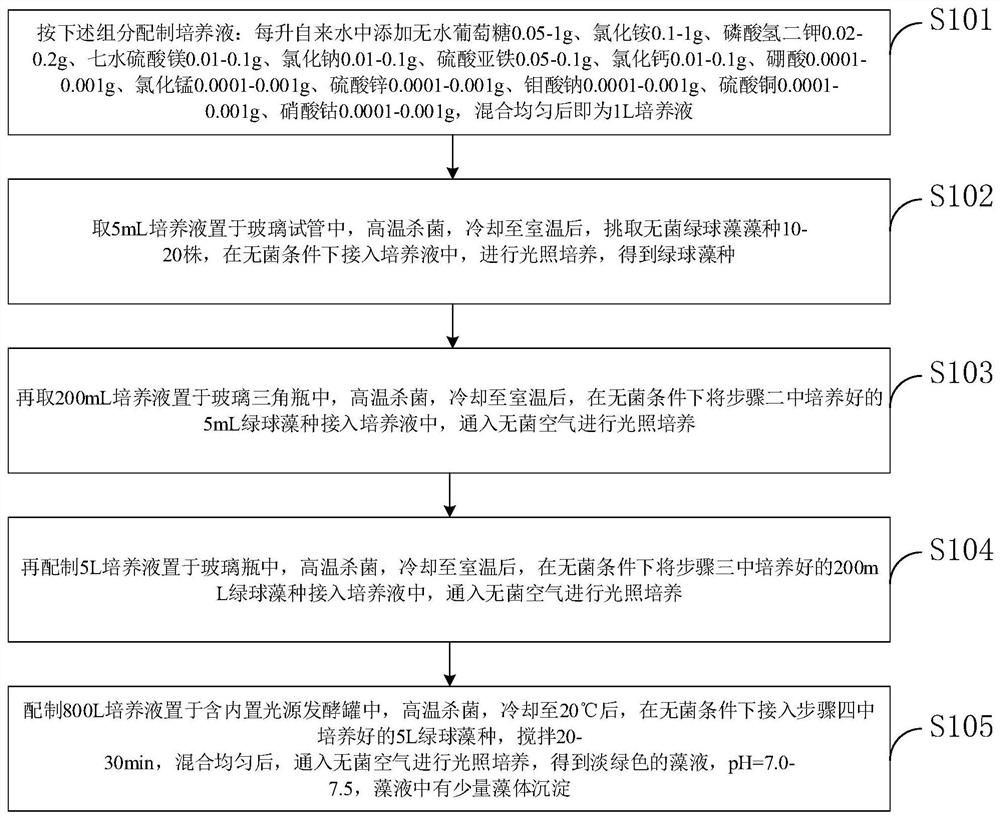Culture solution of low-temperature chlorococcum, culture method and application of low-temperature chlorococcum
A cultivation method, the technology of Chlorococcus, applied in the direction of microorganism-based methods, applications, chemical instruments and methods, etc., can solve the problems of affecting the self-purification speed of water bodies, slow growth of algae, and low concentration of living algae, so as to enhance the self-purification ability of water bodies , increase dissolved oxygen in water, and expand the effect of application fields
- Summary
- Abstract
- Description
- Claims
- Application Information
AI Technical Summary
Problems solved by technology
Method used
Image
Examples
Embodiment 1
[0050] The method for culturing Chlorococcum in this embodiment includes the following steps:
[0051] ① Preparation of culture fluid
[0052] The culture solution is prepared according to the following components: add 0.05g anhydrous glucose, 0.1g ammonium chloride, 0.02g dipotassium hydrogen phosphate, 0.01g magnesium sulfate heptahydrate, 0.01g sodium chloride, and 0.05 ferrous sulfate per liter of tap water. g. Calcium chloride 0.01g, boric acid 0.0001g, manganese chloride 0.0001g, zinc sulfate 0.0001g, sodium molybdate 0.0001g, copper sulfate 0.0001g, cobalt nitrate 0.0001g, adjust pH = 7.0 after mixing, that is 1L Culture medium
[0053] ②Cultivation of Chlorococcus
[0054] a Take 5 mL of the culture solution in a glass test tube, sterilize at 118°C for 12 minutes, after cooling to room temperature, pick 10 sterile Chlorococcum species, and put them into the culture solution under aseptic conditions, 12-25 Cultivate 22h under 1000-1500 Lux light at ℃ (preferably 25℃);
[0055]...
Embodiment 2
[0059] The method for culturing Chlorococcum in this embodiment includes the following steps:
[0060] ① Preparation of culture fluid
[0061] The culture solution was prepared according to the following components: 0.55g anhydrous glucose, 0.5g ammonium chloride, 0.1g dipotassium hydrogen phosphate, 0.05g magnesium sulfate heptahydrate, 0.05g sodium chloride, and 0.55 ferrous sulfate per liter of tap water. g. Calcium chloride 0.05g, boric acid 0.0005g, manganese chloride 0.0005g, zinc sulfate 0.0005g, sodium molybdate 0.0005g, copper sulfate 0.0005g, cobalt nitrate 0.0005g, adjust pH=7.0 after mixing, that is 1L Culture medium
[0062] ②Cultivation of Chlorococcus
[0063] a Take 5 mL of the culture solution in a glass test tube, sterilize it at 121°C for 21 min. After cooling to room temperature, pick 15 sterile Chlorococcus species and put them in the culture solution under aseptic conditions at 25°C. , Cultivate 24h under 1250 Lux light;
[0064] b. Take another 200 mL of the cu...
Embodiment 3
[0068] The method for culturing Chlorococcum in this embodiment includes the following steps:
[0069] ① Preparation of culture fluid
[0070] The culture broth was prepared according to the following components: add 1g anhydrous glucose, 1g ammonium chloride, 0.2g dipotassium hydrogen phosphate, 0.1g magnesium sulfate heptahydrate, 0.1g sodium chloride, 0.1g ferrous sulfate, per liter of tap water. 0.1g of calcium chloride, 0.001g of boric acid, 0.001g of manganese chloride, 0.001g of zinc sulfate, 0.001g of sodium molybdate, 0.001g of copper sulfate, 0.001g of cobalt nitrate, after mixing, adjust pH=7.0, which is 1L of culture medium ;
[0071] ②Cultivation of Chlorococcus
[0072] a Take 5 mL of the culture solution in a glass test tube, sterilize it at 125℃ for 30 min. After cooling to room temperature, pick 20 sterile Chlorococcum species and put them in the culture solution under aseptic conditions at 15℃ , Cultivate for 26h under 1500 Lux light;
[0073] b. Take another 200 mL...
PUM
 Login to View More
Login to View More Abstract
Description
Claims
Application Information
 Login to View More
Login to View More - R&D
- Intellectual Property
- Life Sciences
- Materials
- Tech Scout
- Unparalleled Data Quality
- Higher Quality Content
- 60% Fewer Hallucinations
Browse by: Latest US Patents, China's latest patents, Technical Efficacy Thesaurus, Application Domain, Technology Topic, Popular Technical Reports.
© 2025 PatSnap. All rights reserved.Legal|Privacy policy|Modern Slavery Act Transparency Statement|Sitemap|About US| Contact US: help@patsnap.com



